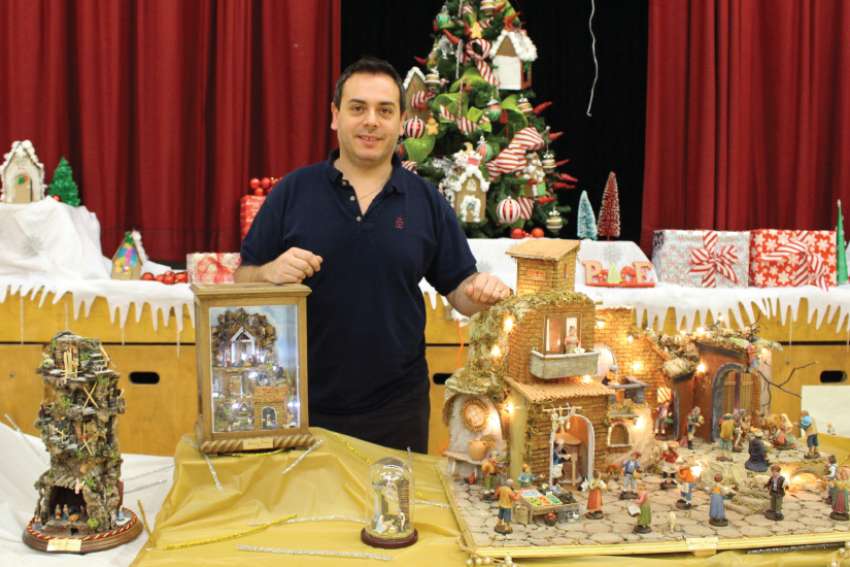Francesco Ferrigno, who arrived in Canada from Italy four years ago, is surrounded by the Nativity scenes he created that are on display at St. Eugene Catholic School.
Photo by Meggie Hoegler
Traditional nativity art from Italy passed down to new generation
By Meggie Hoegler, The Catholic Register
Francesco Ferrigno sums up his first winter in Canada in two words: Cold and lonely.
Living alone in a basement apartment four years ago, he missed his family and the warm Italian sun in Naples.
Two things got him through that first year: his faith and creating presepio, an Italian art form that depicts the Nativity scene. Every time he worked on a piece, he was transported back to his childhood and a family tradition dating back to 1836.
Ferrigno, 37, is no longer cold or lonely. Now, he loves the snow, is happily married to an Italian-Canadian woman and has a three-month-old daughter, Emily.
“I found love and got married to my wonderful wife Stephanie. Now we have little Emily who was born out of this love. They are my life. I tell everyone I have a wife and a fiancée!” said Ferrigno, laughing.
He has a job he loves. As an occasional custodian at Toronto’s St. Eugene Catholic School, Ferrigno wanted to give back to the community that helped him adjust to his new life by donating the Nativity scenes he has been working on the past three years.
“At St. Eugene, I always felt like I was part of the family,” said Ferrigno. “Working in a Catholic community like this is fantastic. This exhibit is just one way for me to show my gratitude to the school board.”
Ferrigno e-mailed Robert Gallo, a religion and family life resource teacher for the Toronto Catholic school board, asking if he could display his pieces.
“We are in the middle of a three-year plan called Parish, Family and School. This is the year of the family, so I thought what better way to showcase that than to feature a family tradition of one of our staff dating back 150 years?” said Gallo.
Once he received permission from St. Eugene’s principal, Kirsten Kelly, Gallo and Ferrigno went to work planning the exhibit.
Gallo is Italian by heritage and speaks the language. He enjoyed hearing stories about the art tradition and Ferrigno’s experience growing up in the heart of Naples.
“My uncle, Francesco Crauso, lived next door to me and he made presepio art,” Ferrigno said. An art form dating back to a commission from St. Francis of Assisi, the figurines are made from terracotta and painted to look as realistic as possible. Neapolitan figures often include religious figures as well as 18th-century scenes with ordinary people — shopkeepers, vendors, butchers and beggars.
“I grew up with these,” he said, gesturing to the 13 Nativity displays (one of which includes an actual running water system.) “I never want to stop creating them. I sold a few of them, but I don’t want to turn it into a business. I want every piece to be an original and to mean something.”
Class by class, teachers bring their students to admire Ferrigno’s creations. The children peer in, marvelling at the tiny lights wired into each display. The running water display is a hit.
“I’ve been wondering how he did that,” said Abby Pader, a Grade 6 student at St. Eugene.
Gallo made a mini documentary on Ferrigno and his creations.
“It’s a story we have to tell,” said Gallo, who filmed the entire documentary on his iPhone. The larger theme of the documentary is the importance of the Nativity and Advent. To illustrate this, he spoke with several students from St. Eugene.
“Advent is a countdown to when Jesus comes,” said Christian Hesse, a Grade 7 student. “The Nativity scenes are a cool way to remember that.”
Ferrigno also uses his Nativity scenes to teach his daughter about the true meaning of Christmas.
“I point to each character and tell her ‘This is the Baby Jesus’ or ‘This is his mother, Mary,’ I want to try to teach her how to make them when she is older,” he said.
Gallo’s documentary can be viewed on the Toronto Catholic Board’s website.
Tagged under:
Please support The Catholic Register
Unlike many media companies, The Catholic Register has never charged readers for access to the news and information on our website. We want to keep our award-winning journalism as widely available as possible. But we need your help.
For more than 125 years, The Register has been a trusted source of faith-based journalism. By making even a small donation you help ensure our future as an important voice in the Catholic Church. If you support the mission of Catholic journalism, please donate today. Thank you.
DONATE

